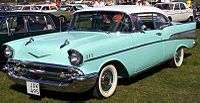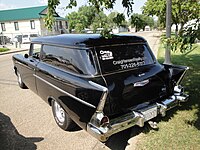1957 Chevrolet
This article needs additional citations for verification. (February 2010) |
| 1957 Chevrolet | |
|---|---|
| Transmission | 3-speed manual Powerglide auto Turboglide auto |
The 1957 Chevrolet is a car that was introduced by Chevrolet in September 1956 for the 1957 model year. It was available in three series models: the upscale Bel Air, the mid-range Two-Ten, and the One-Fifty. A two-door station wagon, the Nomad, was produced as a Bel Air model. An upscale trim option called the Delray was available for Two-Ten 2-door sedans. It is a popular and sought after classic car. These vehicles are often restored to their original condition and sometimes modified. The car's image has been frequently used in toys, graphics, music, movies, and television. The '57 Chevy, as it is often known, is an auto icon.[2]
History
Initially, General Motors executives wanted an entirely new car for 1957, but production delays necessitated the 1955–56 design for one more year.[3] Ed Cole, chief engineer for Chevrolet, dictated a series of changes that significantly increased the cost of the car. These changes included a new dashboard, sealed cowl, and the relocation of air ducts to the headlight pods, which resulted in the distinctive chrome headlight that helped make the 1957 Chevrolet a classic. Fourteen-inch wheels replaced the fifteen-inch wheels from previous years to give the car a lower stance, and a wide grille was used to give the car a wider look from the front. The now famous 1957 Chevrolet tailfins were designed to duplicate the wide look in the rear. Bel Air models, though maintaining the same chassis, powertrains, and body, were given upscale gold trim: the mesh grille insert and front fender chevrons, as well as the "Chevrolet" script on the hood and trunk, were all rendered in anodized gold. The 1957 Chevrolets did not have an oil pressure gauge or a voltmeter.[4] The base engine was an inline 6-cylinder called the Blue Flame Six. The engine was smoother running than the V-8. Carburetion came from a single one-barrel carburetor.
"Tri-Five" 1955–1957 V8
The 1955 model year Chevrolet introduced its now-famous
Body styles
Body choices for 1957 included:
- 2- and 4-door sedans(identified by the pillars between door windows)
- 2-door Sport Coupe (a two-door hardtop - the car has no pillar between the front and back window when the window lowered)
- Sport Sedan (a 4-door hardtop)
- 2-door Utility Sedan, a two-door sedan with a package shelf instead of a rear seat
- Delray Club Coupe, which was a Two-Ten model 2-door sedan with a deluxe interior
- The top-of-the-line 2-door Bel Air Nomad station wagon with a sloped pillar behind the hardtop door and sliding windows at the rear seat, unique ribbed roof sheetmetal and lower roofline height mimicking the hardtop models.
- The basic 2-door Handyman station wagon with an upright sedan trim levels.
- 4-door, six-passenger station wagon (referred to as the Townsman; available in both the Two-Ten and Bel Air series)
- 4-door, nine-passenger station wagon (referred to as the Beauville; only available in the Two-Ten series)
- Convertible
Unlike most competitors, the Chevrolet 4-door hardtop featured a reinforced rear roof structure that gave the car added rigidity and a unique appearance in silhouette. The 1957 Chevrolet was called by some a "Baby Cadillac", because of many styling cues similar to Cadillacs of the time. V8-optioned cars got a large "V" under the Chevrolet script on the hood and trunk lid; the "V: was gold for the Bel Air trim level, and silver-colored chrome for the 210 and 150 trim levels.
The 2-door Bel Air Nomad station wagon had its own distinctive styling, mainly in the roof line and rear deck.
-
1957 Chevrolet One-Fifty 2-door Sedan
-
1957 Chevrolet Bel Air 4-door Sedan
-
1957 Chevrolet Bel Air Sport Coupe
-
1957 Chevrolet Bel Air Sport Sedan
-
1957 Chevrolet Bel Air Convertible
-
1957 Chevrolet Bel Air Nomad 2-door 6-passenger Station Wagon
-
1957 Chevrolet Two-Ten Townsman 4-door 6-passenger Station Wagon
-
1957 Chevrolet One-Fifty Sedan Delivery (non-standard wheels)
Engines
For 1957 there were four standard engine options, a 235.5 cu in (3,859 cc) inline 6-cylinder producing 140 hp (104 kW), a 265 cu in (4,340 cc) V8 "Turbo-Fire" producing 162 hp (121 kW), and two 283 cu in (4,640 cc) V8s: a "Turbo-Fire" twin-barrel carburetor producing 185 hp (138 kW) and a "Super "Turbo-Fire" four-barrel carburetor developing 220 hp (164 kW).[6] To help mechanics distinguish the 265 cu in V8 engine from the red 1956 and 1955 265 cu in V8 engines and the orange 1957 283 cu in V8s, the early 1957 265 cu in V8 engines with manual transmissions were painted a bright yellow-green chartreuse. After November 1956, the 1957 265 cu in V8 engines were painted the same orange as the 1957 283 cu in V8s.
Another optional engine was offered with two four barrel carburetors, the legendary "Duntov" cam and solid lifters. This engine produced 270 hp. 1957 was the first year that Chevrolet ever offered fuel injection as an option. A 283 cu in (4,640 cc) engine fitted with solid lifters, the "Duntov" cam and fuel injection was rated at 283 hp (211 kW) and cost $500.[7][8] This was the first time in history that a General Motors vehicle achieved 1-hp-per-cu-in in a production vehicle. Fuel injection continued as an option throughout the early 1960s. However, most mechanics of the time didn't have the experience to keep the units running properly. This prompted most buyers to opt for conventional carburetion.
In a 1957 survey of owners, Popular Mechanics reported that 16.9% of owners complained about the fuel economy, while 34.4% wanted fuel injection.[9]
Options
There were many options available, most of which were designed to make the car more comfortable and luxurious. Air conditioning was offered though rarely ordered, as was a padded dash. Power steering and power brakes were available, as well as a signal-seeking AM[8] radio and power antenna. Power windows and power seats were also available. A rear speaker could be purchased which required a separate volume knob to be installed in the dashboard, beside the radio — this rear speaker was touted as providing "surround" sound. An "Autronic eye" was offered; it was a device that bolted onto the dashboard and sensed the light from oncoming traffic, dimming the headlights automatically.[10][11] One unique option was an electronic shaver, connected to the dashboard.[12] The 1957 radio used tubes that required only 12 volts of plate voltage and a transistor for the output stage. This lowered the power drain on the battery to an insignificant amount when the engine was off. Playing the radio with conventional tubes for extended periods occasionally drained the battery to the extent that it could not start the car. The clock was electrically self-wound and moving the hands to correct the time resulted in actually regulating the going rate. After a few corrections, the clock was remarkably accurate.
Another dashboard-mounted item was the traffic-light viewer, a ribbed plastic visor that was installed just above the speedometer. Because the roof extends so far forward of the driver, it is hard to see overhead traffic lights. The traffic light viewer captured the reflection of overhead traffic lights so that the driver didn't have to lean forward to see past the edge of the roof. A/C was also an option.[13]
In 1957, Chevrolet started to add safety features such as "crash proof door locks[14]" (first added in 1956), padded dash boards, safety-styled steering wheel with a recessed hub[15] (though not as much as Ford's), seat belts (also first in 1956[16]) and shoulder harnesses.[17][18] However, unlike Ford, Chevrolet did not promote these safety features heavily.
1957 was also Chevrolet's first offering of a turbine transmission, known as the
Post-production popularity


From a numbers standpoint, the 1957 Chevrolet wasn't as popular as General Motors had hoped. Despite its popularity, rival Ford outsold Chevrolet for the 1957 model year for the first time since 1935. The main cause of the sales shift to Ford was that the 1957 Chevrolet had tubeless tires, the first car to have them. This scared away sales to Ford as many people did not initially trust the new tubeless design. Also Ford's introduction of an all-new body styling that was longer, lower, and wider than the previous year's offerings helped Ford sales.[21]
However, the 1957 Ford — with the exception of the rare retractable hardtop model — is not nearly as prized by collectors today as the 1957 Chevrolet.[
The big block, however, was not what put the 1957 on the map on the street scene; it was the introduction of the low-priced small-block, 365-horsepower
The 1957 also won 26 NASCAR "convertible races," more than any make, and won all three possible driver's championships. The first in convertible class and winning car in the 1959 Daytona 500 was a 1957 driven by Joe Lee Johnson. The convertibles started on the outside row and were approximately ten miles an hour slower than the hardtops and sedans because of their aerodynamics. No one figured that a convertible would win the race and they didn't but wonder who was driving the top finishing convertible.
The
Companies such as Danchuk Manufacturing, Inc. and Classic Chevy Club International began selling reproduction and restoration parts. In the early 1990s, the value of a meticulously restored 1957 Chevrolet convertible was as high as $100,000.[citation needed] Although those peaks gave way significantly after 1992, the 1957 Chevrolet has held its value and is now poised to exceed the previous peak.
Although restored original examples are increasingly rare, modern customizers and restorers are creating fast, powerful, ultra-modern hot rods that are winning the 1957 Chevrolet a whole new generation of fans. As original cars become harder to find, fiberglass and all-steel reproductions (EMI in Detroit, Michigan was the first to build restoration bodies using original firewalls with VIN numbers - the steel reproduction bodyshells are manufactured by Real Deal Steel in Sanford, Florida, using reproduction sheetmetal) are making it possible for future generations to enjoy the 1957 Chevrolet.
See also
References
- ^ "Automobile". Retrieved September 20, 2016.
- ^ Epp, Peter (February 25, 2014). "'57 Chevy's iconic popularity has endured". The Petrolia Topic. Archived from the original on May 29, 2014. Retrieved June 6, 2014.
- ^ Trotta, Mark. "1957 Chevy History". www.classic-car-history.com.
- ^ "Directory Index: Chevrolet/1957_Chevrolet/1957_Chevrolet_Owners_Manual". Oldcarbrochures.com. Retrieved February 14, 2012.
- ^ "Directory Index: Chevrolet/1918_Chevrolet/1918_Chevrolet_V8_Brochure". Oldcarbrochures.com. Retrieved February 14, 2012.
- ^ "Old Car Brochures". Retrieved December 16, 2011.
- ^ "1955, 1956, 1957 Chevrolet Nomad". November 27, 2007.
- ^ ISBN 978-0-7864-3229-5.
- ^ "Popular Mechanics - Google Books". Popular Mechanics. April 1957.
- ^ "Directory Index: Chevrolet/1957_Chevrolet/1957_Chevrolet_Accessories". Oldcarbrochures.com. Retrieved February 14, 2012.
- ISBN 9781440230516– via Google Books.
- ^ "Directory Index: Chevrolet/1956_Chevrolet/1956_Chevrolet_Accessories". Oldcarbrochures.com. Retrieved February 14, 2012.
- ^ "Directory Index: Chevrolet/1957_Chevrolet/1957_Chevrolet_Owners_Manual". Oldcarbrochures.com. Retrieved February 14, 2012.
- ^ "Directory Index: Chevrolet/1957_Chevrolet/1957_Chevrolet_Brochure-Cdn". Oldcarbrochures.com. Retrieved February 14, 2012.
- ^ "Directory Index: Chevrolet/1957_Chevrolet/1957_Chevrolet_Brochure_2". Oldcarbrochures.com. Retrieved February 14, 2012.
- ^ "1956 Classic Chevrolet – Accessories". 56classicchevy.com. Retrieved February 14, 2012.
- ^ "1957 Classic Chevrolet – Accessories". 57classicchevy.com. Archived from the original on February 23, 2012. Retrieved February 14, 2012.
- ISBN 0-87341-027-0.
- ^ "Directory Index: Chevrolet/1957_Chevrolet/1957_Chevrolet_Owners_Manual". Oldcarbrochures.com. Retrieved February 14, 2012.
- ^ "Directory Index: Chevrolet/1957_Chevrolet/1957_Chevrolet_Owners_Manual". Oldcarbrochures.com. Retrieved February 14, 2012.
- ^ "1957Ford.com – History". 1957Ford.com. Archived from the original on February 23, 2011.
Forty Years of Stock Car Racing By Greg Fielden.








